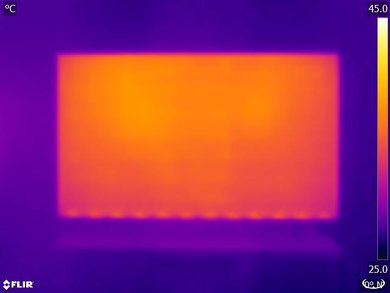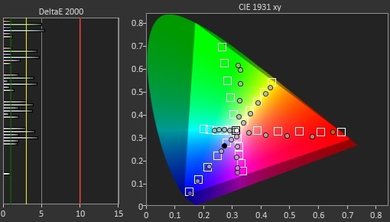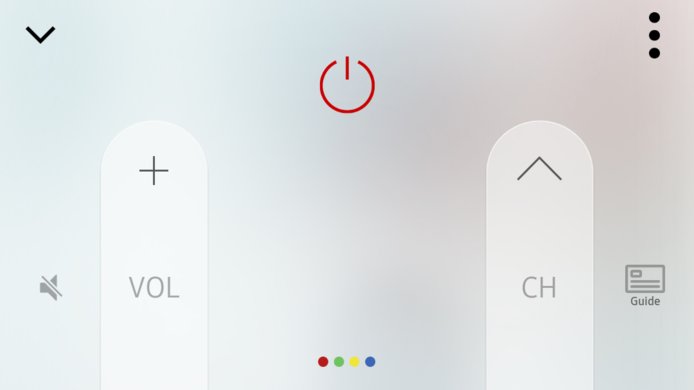Our Verdict
Average TV for a mixed usage. The MU6100's high contrast ratio helps it produce a decent picture quality, and its low input lag keeps games responsive and immersive. However, its narrow viewing angle makes picking viewing positions more difficult, and the mediocre motion performance might be distracting for some.
- Low input lag for gaming
- Great contrast ratio
- Average black uniformity
- Mediocre motion performance
- Picture quality deteriorates at an angle
Passable TVs for watching movies in a dark room. While the MU6100 produces deep blacks thanks to its high contrast ratio, its black uniformity is only average.It also cannot play 24p content without judder, which can be an issue for some people.
Good TV for watching shows in a bright room. Picture quality is decent, and TV can get quite bright to overcome glare and reflections. The smart interface works well for casual viewing too.
Decent for sports in a bright room. Picture quality is fine, and the TV can get quite bright to overcome glare and reflections. Unfortunately, moving objects have some visible blur, and the image degrades when viewed at an angle.
Great for gamers. The picture quality is decent, and the input lag is very low. Unfortunately, some blur can be seen following fast moving objects.
Below average for watching HDR. Although it supports the HDR10 format, it can't produce bright HDR highlights and doesn't support a wide color gamut. The overall picture quality is decent though.
Good for HDR gaming. Although the TV can't produce bright highlights or very saturated colors, it feels responsive due to the low input lag. Unfortunately, some blur may be seen with fast-paced games.
Good choice for a PC monitor. Feels responsive with low input lag, and can display full-color information for clear text on all backgrounds. The picture quality is decent, but the edges of the screen lose accuracy when viewed from up close and some blur is visible when scrolling webpages.
Changelog
- Updated Mar 12, 2018: Converted to Test Bench 1.2.
- Updated Oct 30, 2017: Review published.
- Updated Oct 28, 2017: Our testers have started testing this product.
- Updated Oct 16, 2017: We've purchased the product and are waiting for it to arrive in our lab.
Check Price
Differences Between Sizes And Variants
We tested the 58" (UN58MU6100), the only size available at the moment.
If someone comes across a different type of panel or if their Samsung UN58MU6100 doesn't correspond to our review, let us know and we will update the review.
| Size | Model | Full Name | Alternative name |
| 58" | UN58MU6100 | UN58MU6100AFXZA | UN58MU6100FXZA |
Black Friday Models
For Black Friday, Walmart and Sam's Club have an exclusive variant of the MU6100 with the model name MU6070 (58MU56070, UN58MU6070, UN58MU6070FXZA) that is available in 50" and 58" variants. We expect this TV to have the same performance as the model we've reviewed with some minor cosmetic differences.
There is also a new variant sold at many retailers, known as the UN58MU6070EXZA. We expect this TV to have the same performance as the model we've tested, but there may be some minor differences we're not aware of.
Popular TV Comparisons

The Samsung MU6100 is a decent entry-level 4k LED that offers good value for its size, but it doesn't excel in any aspect in particular, so some TVs might be a better fit depending on your usage. See our recommendations for the best 58-60 inch TVs and the best TVs.
The Samsung MU6300 is marginally better than the Samsung MU6100. The Samsung MU6300 has somewhat better black uniformity and better contrast that produce deep blacks in dimmer rooms. It also comes with better out of the box colors leading to better picture quality in movies, and a slightly better response time which looks good in fast-action video games. The Samsung MU6100 has better reflection handling and viewing angles, which are a plus when watching TV shows in a large room with many windows.
The Samsung NU7100 is slightly better than the Samsung MU6100. The Samsung NU7100 has somewhat better black uniformity which is great for watching HDR movies, and marginally better input lag which is great for playing video games. The Samsung NU7100 has better inputs, which you'll appreciate if you plan to use your TV as a PC monitor, and finally, it has better gray uniformity that is good for sports. The Samsung MU6100 has better reflection handling and SDR peak brightness, which is good if you watch TV shows in a bright room.
The Samsung MU6100 and LG UJ7700 are very similar, but due to the difference in panel types, one may be better than the other depending on your needs. The UJ7700 uses an IPS panel which is better suited for a brighter room with a wide viewing angle. The MU6100 uses a VA panel which has better contrast and black uniformity, making it better suited for a dark room. The UJ7700 uses a different sub-pixel structure which may bother some people for PC use.
The LG UJ6300 has marginally better viewing angles, so it's more suitable if you have a wide room. On the other hand, the Samsung MU6100 is a better TV for most usages. It has better contrast and better black uniformity which is great if you watch a lot of movies or HDR content. It also has better SDR peak brightness to overcome glare in a brighter room where you might enjoy your favorite TV shows. The LG UJ6300 has slightly better response time and marginally better input lag, which make it very responsive for playing video games or for use as a PC monitor.

We buy and test dozens of TVs yearly, taking an objective, data-driven approach to deliver results you can trust. Our testing process is complex, with hundreds of individual tests that take over a week to complete. Most of our tests are done with specially designed test patterns that mimic real content, but we also use the same sources you have at home to ensure our results match the real-world experience. We use two main tools for our testing: a Colorimetry Research CR-100 colorimeter and a CR-250 spectroradiometer.
Test Results
The design of the Samsung MU6100 is quite basic but functional. All of the inputs are fairly easy to access if placed close to a wall as they are angled towards the side of the TV. Unfortunately, the controls are located on the back of the TV similar to the MU6300 and can be a bit difficult to locate as it isn't visible from the front. The stand is wide and made of plastic but provides good support.
The rear of the TV is quite basic, but the textured finish is a nice touch. It looks almost identical to the MU6300, with the same inputs locations and controls. If placed close to a wall the inputs are fairly easy to access which is good.
The build quality of the MU6100 is decent. The stand feels a bit more solid and stable than the MU6300, but all of the exterior of the TV is plastic and the remote feels a bit cheaper than higher-end Samsung models. Overall this isn't an issue for normal use.
The MU6100 does not have a local dimming feature. The video is for reference only.
Good SDR peak brightness, good enough for a moderately bright room. The brightness remains fairly constant which is good, but the TV's CE dimming does make dark scenes darker, as shown by our 2% white window test. This brightness is almost identical to the sister MU6300, and brighter than most competing TVs like the Sony X690E, but not as bright as the smaller TCL P607.
Sub-par HDR peak brightness. The HDR brightness is a little less than the SDR, which is odd, and HDR demands more brightness because highlights in HDR content are often mastered at 1000 or 4000 cd/m². The brightness remains fairly constant, which is good, but the TV's CE dimming makes dark scenes even darker, as shown by our 2% white window test. Overall the brightness is only a little better than competing TVs like the Sony X690E and the Vizio E Series 2017, but far less bright than the smaller TCL P607.
The MU6100 overall gray uniformity is average. On the 50% gray uniformity, we can see that the 4 corners are darker than the middle of the screen. We can also notice some darker and lighter horizontal and vertical bands, which, unfortunately, cause some dirty screen effect.
Examining the 5% gray test picture, we can notice that both sides are lighter, but this is only due viewing angle and is not a real problem when looking at the TV in person. When viewed in person, not many issues can be noticed at all, which is a good result here.
Poor viewing angle, worse that most TVs with an IPS panel but better than most other TVs with a VA panel. Colors deteriorate worst at an angle, while brightness and black level deteriorate more gradually. Still, this TV isn't a good fit for a room where people often sit to the side of the TV and view it at an angle.
The MU6100 black uniformity could be better, as flashlighting can be noticed in each corner of the screen. Besides the flashlighting previously mention, the rest of the screen, especially the center, is free of major defects. As the MU6100 is missing a local dimming feature, the black uniformity can't be made better by turning it on.
The Samsung MU6100 has a semi-gloss finish which is decent at handling reflections. Direct reflections are diffused on the screen, reducing their intensity. This should be fine for an average room but may be an issue in a bright room.
Out of the box, when set on the 'Movie' picture mode and 'Warm2' color tone (the most accurate setting available), the MU6100 accuracy is disappointing. The white balance dE and Color dE are both high enough so that most enthusiasts could notice the inaccuracy and the gamma is also over our desired 2.2 target.
If you find the color temperature a bit too warm, the 'Warm1' color tone is a bit colder and has about the same accuracy, but note that all other color tones settings have a much higher level of inaccuracy.
After calibration, the accuracy of the MU6100 is excellent. The white balance dE was brought down to a mear 0.20, which at this level, imperfection are unnoticeable for most people, and the gamma curve was flattened and now track our 2.2 target almost perfectly. As for the color dE, it was brought down considerably to 1.97, which is good, but some professional could still notice some inaccuracy, but for most people, this is very acceptable.
You can see our calibration settings here.
Standard color gamut, only good enough for SDR content. Most of the colors in HDR content will be shown fairly well, but areas of extreme color will not be shown as saturated as intended. The TV's accuracy at showing the colors it's able to is also not very good, as the majenta and green shades don't follow their target lines properly. HDR content will still look decent, but not as good as on a TV with a wider color gamut.
The TV's EOTF in the Movie picture mode follows the target PQ curve fairly well, but is a little too dim. Adjusting the 'Gamma' slider to '+2' makes the EOTF follow the PQ curve almost perfectly, as shown here. Users can raise the gamma slider to suit their room brightness. The EOTF in 'Game' mode is very similar to the one in 'Movie', while the 'PC' mode EOTF follows the PQ quite closely without any adjustment.
Sub-par color volume, but fairly typical for a TV without a wide color gamut. The TV does do a good job of showing its full color gamut at a large range of different brigntnesses, except at extremely low brightnesses that the TV can't achieve due to its limited contrast ratio and lack of local dimming.
The MU6100 is very good at displaying our gradient test image. Some little imperfection can be noticed in the dark color, especially in the dark green and blue, but none of the banding normally linked to an 8-bit panel can be noticed. Fortunately, even though there is some imperfection in our gradient test image, movies and TV show does not show many signs of color banding.
The MU6100 is free of temporary image retention when exposed to a static image for a short time, as seen on our test picture, taken right after an exposure to a static image for 10 minutes.
We don't expect VA panels to experience permanent image retention, as the VA panel in our long-term test appears immune.
Decent response time, good enough for most content but fast moving content may appear a little blurry. A long trail can be seen following our moving logo, but fortunately the trail is very faint. While the motion isn't bad, many other competing TVs have a faster response time like the Sony X690E and Vizio E Series 2017.
The TV dims the backlight without using PWM from 'Backlight' setting 20/20 until 13/20, then it dims using PWM from 'Backlight' 12/20 until 0/20. This means that the screen will not have flicker when at high brightness, but at mid brightness and below the TV will have worse flicker the dimmer it gets. Because the flicker is at 120 Hz it won't be very noticeable, but it will cause double image artifacts during motion, as seen in the photo in the motion blur section. This means that the TV has worse motion when the backlight is dim, while TVs without flicker like the Sony X690E have good motion no matter their brightness.
The TV has a black frame insertion setting called 'LED Clear Motion', that intentionally adds flicker to make motion much clearer when watching 60 Hz content like video games. This produces excellent 60 Hz motion as seen in the above photo, but the flickering it introduces may be distracting to some users, and it unfortunately doesn't work in game mode.
This TV is great at showing content without stutter, even low frame rate content such as movies. 60 fps content plays very smoothly, and for 24 fps content there is only 17ms of static imagery for each frame which is great.
Similarly to the MU6300, the MU6100 can't remove judder from 24p movies. From 24p sources like a Blu-ray players (24p) or from cable boxes (60p), 24p movies always show some judder. This is not a deal breaker for most people though, as not everyone is sensitive to judder.
The MU6100 doesn't support variable refresh rate features.
Excellent input lag, good enough for all but the most competitive gamers. 'Game' and 'PC' mode have the same low input lag, but only 'PC' mode can properly show 4:4:4 color for PC use. Overall the input lag is the same as most other Samsung TVs, and better than most Sony TVs, but a little worse than some LG and TCL TVs like the TCL P607.
Most common input resolutions are supported. 4k @ 60 Hz @ 4:4:4 or 4:2:2 color is only supported when 'HDMI UHD Color' is enabled. 4:4:4 color is only shown properly when the HDMI input's label is changed to 'PC' (aka PC mode). PC mode doesn't work properly for some input refresh rates such as 24 Hz; the label changes to PC but the settings that are normally disabled in PC mode are not disabled, and 4:4:4 color isn't shown properly.
Only one between Dolby Digital and DTS can be enabled at a time, the TV will not switch between them automatically depending on the content played.
Average frequency response. The MU6100 follows our target decently, but its limited low-frequency extension can make its signature seem a bit thin. Additionally, the MU6100 lacks a room correction feature that could reduce the impact of resonances in the lower mid-range. Unfortunately, dynamic range compression is also present at higher volumes.
Average distortion performance. The MU6100 has no issue maintaining low distortion levels at average listening volumes, but IMD rises significantly the higher the volume is set.
The interface is centered around the Smart Hub, which gives access to the rest of the TV's settings. This makes the TV easy to understand for first time users, yet for more advanced users there are also dedicated buttons on the remote to open settings directly. The second row of the Smart Hub contains quick settings and suggested content, depending on the icon under focus, which can be faster than opening the icon itself.
The TV did not show any ads during testing, however ads on Samsung TVs are often inconsistent. It can be assumed that the TV has ads because all Samsung TVs since 2016 have had ads, and ads were visible on several 2017 Samsung TVs during our testing. If anyone notices ads on their MU6100 please send us a photo by email, we'll update the review.
The TV comes preloaded with many popular apps like Netflix and Google Play Movies and TV. Many more apps are available from the Samsung app store, which offers more apps than most other smart platforms.
The MU6100 only comes with a basic Samsung remote without any smart features such as voice control, and can't be used with the Samsung smart remotes from other TVs. The remote is fairly light had has a good semi-circle shape in hand, but its rubber chunk buttons aren't as easy to press as the buttons of some other remotes.
The Samsung Smart View app works with this TV, apart from the voice control function which is missing because the remote doesn't have voice control. The app has a few useful features such as streaming files off a smartphone or tablet, but is missing some other features such as text entry.















































